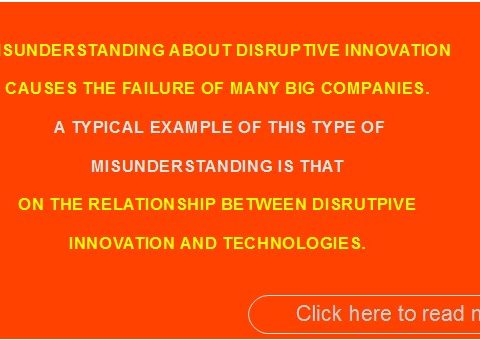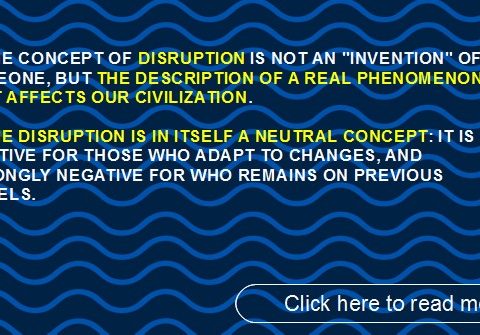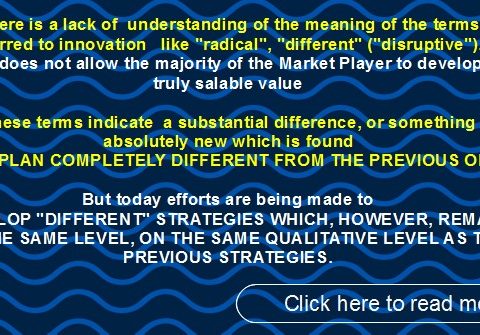■ Collection of Articles: ►§ DISRUPTION / DISRUPTIVE INNOVATION
term-evid
∙The concept of Innovation (introduction to the Disruptive Innovation) [1]
THE CONCEPT OF INNOVATION IN ITSELF MUST BE RADICALLY CHANGED.
Innovation based on a continuous improvement of the products does not work when in History there are radical changes (as it was, for example, in the Industrial Revolution, or as it happens now).
Guidelines [2]: WHAT IS and WHAT IS NOT Disruptive innovation
INTRODUCTION: THE NEED TO CLARIFY THE MEANING OF THE FUNDAMENTALS OF THE MARKET (OF THE BUSINESS) Today, most of the big Companies’ strategies are bankrupt….
Disruptive innovation in practice [1]: what are the criteria for evaluating Disruptive Innovation?
The redefinition of the term Disruptive by its “inventor” the essence of Disruptive Innovation it’s not disruption (disorder, destruction) But it is THE “USEFUL VALUE”…
INTRODUCTION
TO GUIDELINES TO DISRUPTIVE INNOVATION
Today, the many failures derive precisely from the lack of understanding of the essence of Disruptive innovation: The purpose of the Guidelines is to CLARIFY WHAT THE DISRUTPIVE INNOVATION REALLY IS. You can easily evaluate THE RESPONSE OF A BUSINESS TO THE RULES OF THE DISRUTPIVE INNOVATION
Rules Of Disruptive Innovation (Table)
The Market innovation required today is Disruptive Innovation. Competitive advantage of the Product is no longer in improving the current types of products, but in…
Guidelines [3]: Table for Assessing Disruptive Innovation
Disruptive Innovation require new Disruptive Criteria. A Table of Keypoints aimed at a diagnostic assessments of Business innovation capacity.
Guidelines [1]: Basic Q&A on Disruptive innovation
We live in a time of profound social, market and government changes, which are the cause of a profound crisis (social chaos, economic crisis, etc.)….
The drive for change: the urgent needs of Customer
We live in a historical moment like those that preceded the phases of radical change as it was, for example, for the French Revolution: people…
The Disruptive Innovation: key points
There are at least two types of innovation, the one incompatible with the other: ► incremental innovation (a linear evolution made of an increase in…
Are the Autonomous Vehicles really disruptive?
Can Autonomous Vehicles be successful products in the current Disruption Market? Short Aswer: AUTONOMOUS VEHICLE DOES NOT REPRESENT DISRUPTIVE INNOVATION <see Why developing technologies are…
Why disruptive innovation is not an option
We are at a breaking point° (disruption point °) of the evolution of the Market (of the Western Society): change (radical, disruptive)TODAY IT IS NOT…
Why current Design (and hi-tech) and disruptive innovation are incompatible (the “Human factor”)
● What IS and what IS NOT disrutpive innovation ● Why developing technologies are incompatible with disrutpive innovation ● What to do?
∙What disruption essentially is
► The concept of disruption is not an “invention” of someone, but the description of a real phenomenon that affects our civilization. ► THE DISRUPTION IS IN ITSELF A NEUTRAL CONCEPT: it is positive for those who adapt to changes, and strongly negative for who remains on previous Models.
°The difficulty of understanding (to explain) the concept of radical change (disruptive innovation)
There is a lack of of the meaning of the terms referred to innovation like “radical”, “different” (“disruptive”). This does not allow the majority of the Market Player to develop a truly salable value. These terms indicate a substantial difference, or something absolutely new which is found on a plan completely different from the previous one. but today efforts are being made to develop “different” strategies which, however, remain on the same level, on the same qualitative level as the previous strategies.
The basic misunderstanding on Real (Disruptive) Innovation
Disruptive innovation is a “revolution” of the context in which it operates: this means “radical change” (from the roots) of culture, of the mindset used up to that point (change of operating principles, of conception of values, of a design approach, of types of communication, etc.).












